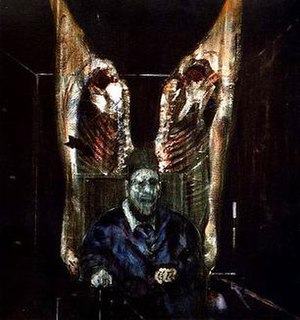| Figure with Meat | |
|---|---|
 | |
| Artist | Francis Bacon |
| Year | 1954 |
| Medium | Oil on canvas |
| Dimensions | 129.9 cm × 121.9 cm (51.1 in × 48.0 in) |
| Location | Art Institute of Chicago, Chicago |
Figure with Meat is a 1954 painting by the Irish-born artist Francis Bacon. The figure is based on the Pope Innocent X portrait by Diego Velázquez; however, in the Bacon painting the Pope is shown as a gruesome figure and placed between two bisected halves of a cow.
The carcass hanging in the background is likely derived from Rembrandt's Slaughtered Ox, 1655. The painting is in the permanent collection of the Art Institute of Chicago.[1]
Description
[edit]
According to Mary Louise Schumacher of the Milwaukee Journal Sentinel, "Bacon appropriated the famous portrait, with its subject, enthroned and draped in satins and lace, his stare stern and full of authority. In Bacon's version, animal carcasses hang at the pope's back, creating a raw and disturbing Crucifixion-like composition. The pope's hands, elegant and poised in Velázquez's version, are rough hewn and gripping the church's seat of authority in apparent terror. His mouth is held in a scream and black striations drip down from the pope's nose to his neck.
The fresh meat recalls the lavish arrangements of fruits, meats and confections in 17th-century vanitas paintings, which usually carried subtle moralizing messages about the impermanence of life and the spiritual dangers of sensual pleasures. Sometimes, the food itself showed signs of being overripe or spoiled, to make the point. Bacon weds the imagery of salvation, worldly decadence, power and carnal sensuality, and he contrasts those things with his own far more palpable and existential view of damnation".[2]
Influence
[edit]The painting is featured in Tim Burton's 1989 film Batman. Criminals led by the Joker break into an art museum and vandalize various works of art; but upon seeing Figure with Meat, the Joker stops one of his men from damaging it, remarking "I kind of like this one [...] Leave it."[3] Craig Shaw Gardner's novelization explains that it was in that art that Joker saw "A black-and-white figure, screaming with pain and anguish and madness, a creature both pitiful and terrifying in its intensity, as if it contained all the pain and anguish and madness in the world."[4]
See also
[edit]Citations
[edit]- ^ Bacon, Francis. "Figure with Meat". The Art Institute of Chicago. Retrieved 17 May 2021.
- ^ Batman, the Joker, and Francis Bacon's Figure with Meat. Chronological Snobbery, Retrieved on March 17, 2010.
- ^ Kroll, Jack (26 June 1989). "The Joker is Wild, but Batman Carries the Night". Newsweek. Tim Burton Collective. Archived from the original on 30 June 2015. Retrieved 16 October 2015. For this and the wider context see Keazor, Henry: “'I make art – until someone dies'. Francis Bacon im Spielfilm“, in: FilmKunst. Studien an den Grenzen der Künste und Medien, edited by Henry Keazor, Fabienne Liptay and Susanne Marschall, Marburg 2011, p. 122–155
- ^ Gardner, Craig Shaw. Batman. Warner Books, 1989. pg 106